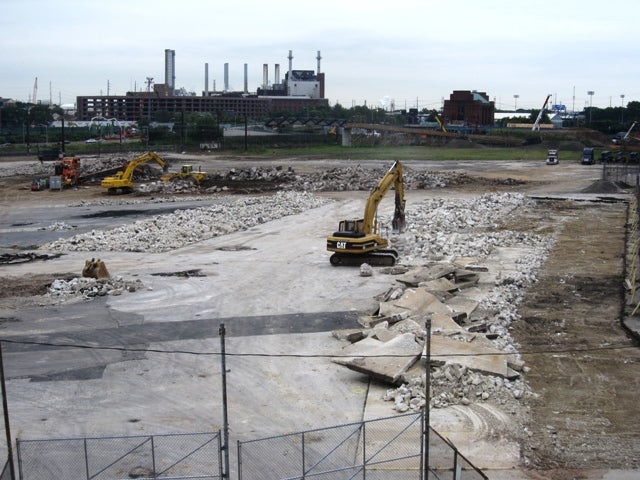Penn Park progress / September 16

On Feb. 26, 2009, Architect Michael Van Valkenburgh unveiled the model for Penn Park, the principal project on the former postal lands. While the plan includes a parking lot for 300 cars, the park is enhancing a desperately desolate concrete landscape into a large, vast open space. David Hollenberg said “it was the first time that Penn had the opportunity to design open space of this magnitude.”
The University did not always show this regard for the neighborhoods around it. For example, in the 1960s and 1970s, the Redevelopment Authority acquired and then demolished residential and commercial neighborhoods (around 6 million square feet in all) to allow for Penn expansion. The most prominent case in point is the University’s superblock at 40th and Walnut, which compressed four city blocks into one, creating three high-rise housing dormitories for students that were out of scale with the original neighborhood.
“In the 1950s and 60s,” Praxis Director Harris Steinberg adds, “the University wanted to create an inward facing campus. In turn, this had a negative impact on the surrounding communities.” Now with Penn Connects, Steinberg believes, the University has had a philosophical change in the way its campus should physically and visually interact with the city. With Penn Connects, Penn hopes to create a beneficial environment not just for its students and faculty, but for all Philadelphians as well. “We wanted to be good stewards of the land” this time, said Anne Papageorge, the Vice President of Facilities and Real Estate Services.
The proposal for Penn Park calls for three playing fields, a dome to cover a field during winter months, a 12-court tennis center, a softball stadium and possibly a ropes course on the eastern edge of campus between Walnut Street and South Street against the Schuylkill River.
Papageorge says the final plans will all depend on funding as some things (e.g. the softball field) take priority over others (e.g. the ropes course). The current design of the park is also environmentally friendly, as it includes storm water management and features native plants of the region. According to Papageorge, the first phase of the park is scheduled to open spring 2011.
“The ultimate goal,” says Papageorge, “is to make this area alive with 24/7 activity.” Over time (and with appropriate funding), Papageorge says the northern edge of Penn Park will eventually become a mixed-used development to include office, retail and residences for the university and city.
WHYY is your source for fact-based, in-depth journalism and information. As a nonprofit organization, we rely on financial support from readers like you. Please give today.





